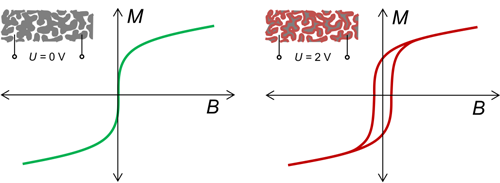FWF - Nanoporös - In-situ magnetometry of nanoporous metals during dealloying and charging
This project is dealing with magnetic studies of nanoporous metals and alloys made by so-called dealloying, an (electro-)chemical process in which the less noble component is removed from an alloy by selective etching. Their high surface-to-volume ratio makes this class of materials not only attractive for applications such as sensing or catalysis but also predestined for property tuning by electrochemical charging. The idea is that by imposing high surface charge densities at surface-electrolyte interfaces, overall macroscopic materials properties, such as the magnetic moment, can be modified in a controlled manner. Based on our recent progress on the development of in-situ techniques for studying variations of magnetic moments with high sensitivity in a magnetometer under full control of ongoing electrochemical processes, the focus of the present project is on in-situ magnetometry of nanoporous metals during dealloying and charging. Palladium and Pd-rich Pd-Co alloys are chosen as model system, because owing to the electronic properties of Pd a particular high sensitivity of the magnetic moment is anticipated with respect to charging. The project aims to answer the question of the primary mechanism which underlies the charging-induced process. The challenging question will be tackled whether magnetism can be made switchable, i.e., whether a charging-induced transition between the paramagnetic and ferromagnetic state can be accomplished by proper adjusting the chemical composition of Pd-Co. The in-situ method will further be used to study the dealloying process itself by continuously magnetic monitoring the electrochemical dissolution of Co. For the purpose of reference, comparative studies on well-defined thin-film model system will be performed. The project is breaking new ground in research, as well as with respect to the class of materials, the scientific questions, and the applied methods. The planned in-situ studies will contribute to a better understanding of the dealloying process of this highly interesting class of materials. Particular attractive with respect to magnetism are the prospects of switchable magnetism by an applied voltage. An important method-oriented aspect of this project will be the successful further implementation and application of the magnetic in-situ measuring technique as well as its extension to novel issues, such as in-situ dealloying. This kind of in-situ magnetic monitoring of electrochemical processes at surfaces and interfaces offers widespread applications in innovative materials science, ranging from ultrathin magnetic films to energy materials, such as battery materials.
Persons involved: Roland Würschum, Eva Steyskal, Markus Gößler
17/07/17 → 30/10/20
return
